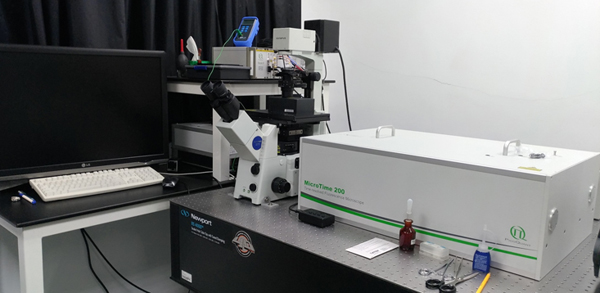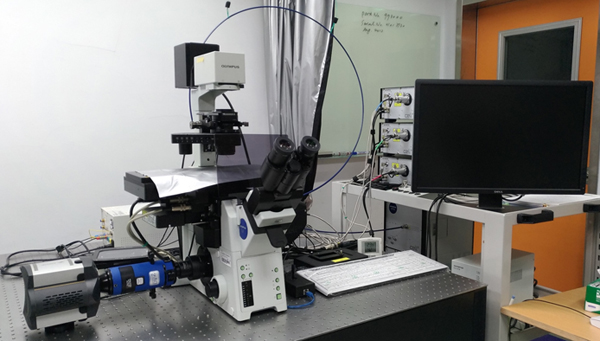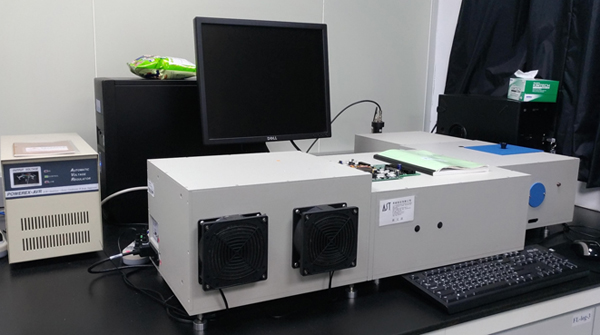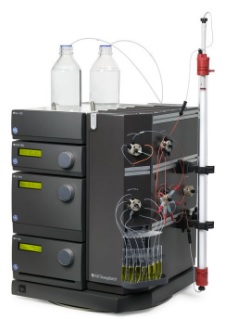Single-Molecule Biology Core Lab
-
- SpecialtySingle-molecule biophysics, Neuropharmacology, Signal transduction
- E-mailwchuang1@gate.sinica.edu.tw
- Tel02-2787-1536
- LabR526/ICOB


The main purpose of establishing the Single-Molecule Biology Core (SMBC) laboratory is to provide a user-friendly platform that bridges the gap between biology and biophysics. The biophysical experiments that are coordinated by the SMBC may be applied to many of the various interdisciplinary areas within Academia Sinica. The service encompasses several functions, including protein purification, determining the physical chemistry properties of fluorescence molecules, single-cell or single-molecule imaging, and probing the interactions between single molecules. Facilities for the SMBC have been adapted from an academician, Dr. Tao-Shih Hsieh's laboratory and are described below. The SMBC aims to maintain all of the unique facilities that were established by Dr. Hsieh and to provide a continued source of information, expertise, and service, which will allow researchers with complete or limited knowledge of these techniques to apply the methods to their research.
Time-Resolved Confocal Fluorescence Microscopy, Micro Time 200 (PicoQuant), a commercial microscopy, allows us to record virtually all aspects of the fluorescence dynamics. With the TCSPC (Time-Correlated Single Photon Counting) method and the SymPhoTime software, MT200 cover broad research topics from biological, medical and chemical to physical sciences. The most prominent measurement and the analysis methods, including, FLIM (Fluorescence Lifetime Imaging), FCS (Fluorescence Correlation Spectroscopy), and FRET (FÖster Resonance Energy Transfer) are applicable under the current setup.

Based on the objective-type of TIRF Microscopy, the incident angle of the excitation laser is adjusted through the back focal plane on the objective lens to induce the total internal reflection. Fluorescence molecules, which are close to the surface of coverslips within the evanescence wave propagating depth of 100 nm, can be observed. In the combination of fluorescence technique such as FRET, a variety of biological studies such as molecule interaction and protein folding/unfolding, dynamics of DNA, RNA, proteins, and large protein complexes, can be addressed. Following analysis of single molecule intensities and FRET trajectories, the structural dynamics of these molecules can be probed.

Apart from the single molecule measurement, TIRF microscopy can be used routinely on the imaging of membrane proteins, channels, and receptors that have the expression on the cell surface. Pharmacological analysis of ligand and receptor binding, and the tracking of the downstream cascade of signal transduction molecules, exocytosis and endocytosis of the neurotransmitters at chemical synapses, could also be fulfilled by the current TIRF setup.


| Name | Job Title | Telephone | Remark | |
|---|---|---|---|---|
| Wan-Chen Huang | Associate Research Scientist | (02) 2787-1536 | wchuang1@gate.sinica.edu.tw | R526 |
| Ya-Ting Chuang | Research Assistant | (02) 2787-1532 | as0201737@gate.sinica.edu.tw | R530-1 |
1. Wang YS, Yeh TK, Chang WC, Liou JP, Liu YM, Huang WC. (2022) 2,6-Difluorobenzamide derivatives as store-operated calcium channel (SOC) inhibitors. Eur J Med Chem. 243:114773.
2. Mugiyanto E, Adikusuma W, Irham LM, Huang WC, Chang WC, Kuo CN. (2022) Integrated genomic analysis to identify druggable targets for pancreatic cancer. Front Oncol. 12:989077.
3. Hsu YW, Wong HS, Huang WC, Yeh YH, Hsiao CD, Chang WC, Hsieh SL. (2022) Human rs75776403 polymorphism links differential phenotypic and clinical outcomes to a CLEC18A p.T151M-driven multiomics. J Biomed Sci. 29(1):43.
4. Wang YS, Huang NK, Lin YC, Chang WC, Huang WC. (2022) Aspirin and Sulindac act via different mechanisms to inhibit store-operated calcium channel: Implications for colorectal cancer metastasis. Biomed Pharmacother. 145:112476.
5. Wang YJ, Mugiyanto E, Peng YT, Huang WC, Chou WH, Lee CC, Wang YS, Irham LM, Perwitasari DA, Hsu MI, Chang WC. (2021) Genetic Association of the Functional WDR4 Gene in Male Fertility. J Pers Med. 11(8):760.
6. Hsieh HW, Chen SC, Huang WC, Fang S, Yang EC, Hsu CC, Kou R. (2021) Social interactions upregulate hemolymph tryptophan and tyrosine levels in the male lobster cockroach. Horm Behav. 130:104935.
7. Muhammad Irham L, Chou WH, Wang YS, Adikusuma W, Sung-Ching Wong H, Aryani Perwitasari D, Huang WC, Chen BK, Yang HI, Chang WC. (2020) Evaluation for the Genetic Association between Store-Operated Calcium Influx Pathway (STIM1 and ORAI1) and Human Hepatocellular Carcinoma in Patients with Chronic Hepatitis B Infection. Biology (Basel). 9(11):388.
8. Irham LM, Wong HS, Chou WH, Adikusuma W, Mugiyanto E, Huang WC*, Chang WC. (2020) Integration of genetic variants and gene network for drug repurposing in colorectal cancer. Pharmacol Res. 161:105203.
9. Lee YC, Huang WC, Lin JH, Kao TJ, Lin HC, Lee KH, Lin HC, Shen CJ, Chang WC, Huang CC. (2018) Znf179 E3 ligase-mediated TDP-43 polyubiquitination is involved in TDP-43- ubiquitinated inclusions (UBI) (+)-related neurodegenerative pathology. J Biomed Sci. 25(1):76.
10. Huang WC*, Lee CY, Hsieh TS. (2017) Single-molecule FRET analysis discloses the dynamics of the DNA-topoisomerase II (TOP2) interaction in the presence of TOP2-targeting agents. Journal of Biological Chemistry. 292(30):12589-12598. (*Corresponding author)
11. Wei WC, Huang WC, Lin YP, Becker EBE, Ansorge O, Flockerzi V, Conti D, Cenacchi G, Glitsch MD. (2017) Functional expression of calcium-permeable canonical transient receptor potential 4-containing channels promotes migration of medulloblastoma cells. J Physiol. 595(16):5525-5544.
12. Lin S, Hong CH, Sheu BC, Wu LX, Huang WC, Huang WC, Guo CY (2016) Dynamic response of HPV16/anti-HPV16 pairs with unbinding events studied by atomic force microscopy. Biochemistry and Biophysics Reports. 6:203-208
13. Shen CJ, Chan SH, Lee CT, Huang WC, Tsai JP and Chen BK. (2016) Oleic acid-induced ANGPTL4 enhances head and neck squamous cell carcinoma anoikis resistance and metastasis via up-regulation of fibronectin. Cancer Letters. 386:110-122. (IF: 5.992)
14. Liao YH, Chiang KH , Shieh JM, Huang CR , Shen CJ, Huang WC* and Chen BK*. (2016) Epidermal growth factor-induced ANGPTL4 enhances anoikis resistance and tumor metastasis in head and neck squamous cell carcinoma. Oncogene. DOI: 10.1038/onc.2016.371 (IF: 8.459, co-corresponding author)
15. Wong SC, Chang CM, Huang WC*, and Chang WC*. (2016) Genetic and molecular characteristics associated with local cytokines and related molecules across human cancers. OncoImmunology. 5(11):e1214789. (IF: 7.6, co-corresponding author)
16. Klahan S, Huang WC, Chang CM, Wong HS, Huang CC, Wu MS, Lin YC, Lu HF, Hou MF, Chang WC. (2016) Gene expression profiling combined with functional analysis identify integrin beta1 (ITGB1) as a potential prognosis biomarker in triple negative breast cancer. Pharmacol Res. 104:31-7. (IF:4.4)
17. Chang WC, Wu SL, Huang WC, Hsu JY, Chan SH, Wang JM, Tsai JP, Chen BK. (2015) PTX3 gene activation in EGF-induced head and neck cancer cell metastasis. Oncotarget. 6(10):7741-57. (IF:6.63)
18. Shieh JM, Shen CJ, Chang WC, Cheng HC, Chan YY, Huang WC, Chang WC, Chen BK. (2014) An increase in reactive oxygen species by deregulation of ARNT enhances chemotherapeutic drug-induced cancer cell death. PLoS One. 9(6):e99242. (IF:3.73)
19. Lin YS, Huang WC, Chen MS, Hsieh TS. (2014) Toward discovering new anti-cancer agents targeting topoisomerase IIα: a facile screening strategy adaptable to high throughput platform. PLoS One. 9(5):e97008. (IF:3.73)
20. Huang WC, Chai CY, Chen WC, Hou MF, Wang YS, Chiu YC, Lu SR, Chang WC, Juo SH, Wang JY, Chang WC. (2011) Histamine regulates cyclooxygenase 2 gene activation through Orai1-mediated NFkB activation in lung cancer cells. Cell Calcium. 50:27-3. (IF:4.32)
21. Chou YH, Woon PY, Huang WC, Shiurba R, Tsai YT, Wang YS, Hsieh TJ, Chang WC, Chuang HY, Chang WC. (2011) Divalent lead cations induce cyclooxygenase-2 gene expression by epidermal growth factor receptor/nuclear factor-kappa B signaling in A431carcinoma cells. Toxicol Lett. 203(2):147-53
22. Huang WC, Chen ST, Chang WC, Chang KY, Chang WC, Chen BK. (2010) Involvement of aryl hydrocarbon receptor nuclear translocator in EGF-induced c-Jun/Sp1-mediated gene expression. Cellular and Molecular Life Science. 67(20):3523-33. (IF: 6.09)
23. Huang WC, Swietach P, Vaughan-Jones RD, Ansorge O, Glitsch MD. (2009) Differentiation impairs low pH-induced Ca2+ signaling and ERK phosphorylation in granule precursor tumour cells. Cell Calcium. 45(4):391-9. (IF:4.32)
24. Huang WC, Swietach P, Vaughan-Jones RD, Ansorge O, Glitsch MD. (2008) Extracellular acidification elicits spatially and temporally distinct Ca2+ signals. Current Biology. 18:781-5 (IF:10.988)
25. Su MC, Huang WC, Lien HC. (2008) Beta-catenin expression and mutation in adult and pediatric Wilm's tumors. APMIS. 116(9):771-8.
26. Huang WC, Young JS, Glitsch MD (2007) Changes in TRPC channel expression during postnatal development of cerebellar neurons. Cell Calcium. 42:1-10 (IF:4.32)
27. Wen HC, Huang WC, Ali A, Woodgett JR, Lin WW (2002) Negative regulation of phosphatidylinositol 3-kinase and Akt signalling pathway by PKC. Cellular Signalling. 15:37-45
28. Huang WC, Chio CC, Chi KH, Wu HM, Lin WW (2002) Superoxide anion-dependent Raf/MEK/ERK activation by perxisome proliferator activated receptor gamma agonists 15-deoxy-delta(12,14)-prostaglandin J(2), ciglitazone, and GW1929. Exp Cell Res. 277(2):192-200.
29. Hsu YW, Chi KH, Huang WC, Lin WW (2001) Ceramide inhibits lipopolysaccharide-mediated nitric oxide synthase and cyclooxygenase-2 induction in macrophages: effects on protein kinases and transcription factors. The Journal of Immunology. 166(9):5388-5397
30. Wen HC, Huang WC, Ali A, Woodgett JR, Lin WW (2002) Negative regulation of phosphatidylinositol 3-kinase and Akt signalling pathway by PKC. Cellular Signalling. 15:37-45
31. Huang WC, Chio CC, Chi KH, Wu HM, Lin WW (2002) Superoxide anion-dependent Raf/MEK/ERK activation by peroxisome proliferator activated receptor gamma agonists 15-deoxy-delta(12,14)-prostaglandin J(2), ciglitazone, and GW1929. Exp Cell Res. 277(2):192-200.
32. Hsu YW, Chi KH, Huang WC, Lin WW (2001) Ceramide inhibits lipopolysaccharide-mediated nitric oxide synthase and cyclooxygenase-2 induction in macrophages: effects on protein kinases and transcription factors. The Journal of Immunology. 166(9):5388-5397